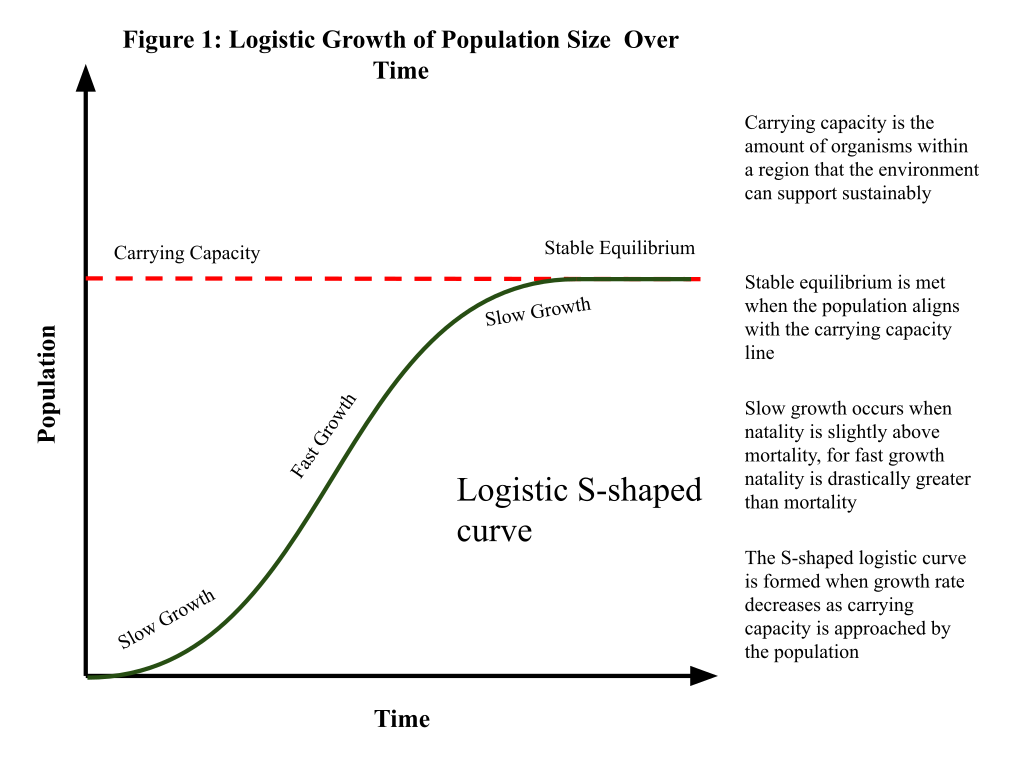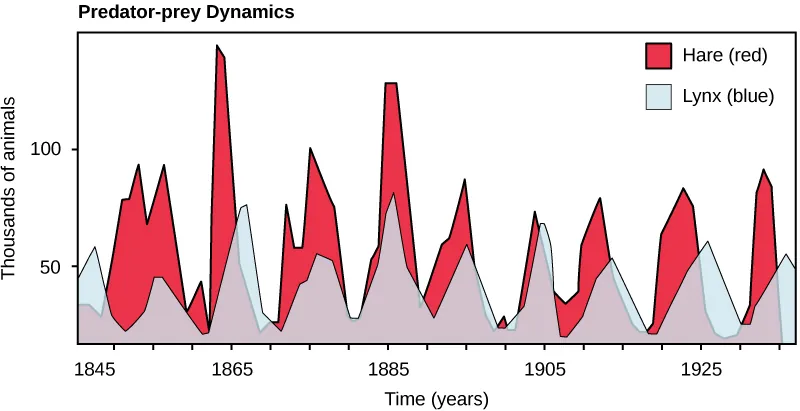IB Syllabus focus:
‘Carrying capacity is maximum population size set by limited resources. Density-dependent factors (competition, predation, disease) stabilise populations via negative feedback. Growth shows J-curves without limits, S-curves with limits, and occasional boom-bust cycles.’
Carrying capacity describes the limits ecosystems impose on populations. Growth patterns, resource regulation, and feedback processes explain how species thrive, stabilise, or collapse under environmental conditions.
Carrying Capacity
Carrying capacity refers to the maximum number of individuals of a species that an environment can sustainably support, given the availability of resources such as food, water, and shelter. This is not a fixed number but can change with seasonal variation, resource fluctuations, or human interference.
Carrying Capacity: The maximum population size that an environment can support indefinitely without degrading resources or ecosystem stability.
The balance between births, deaths, immigration, and emigration determines whether populations approach, exceed, or remain below carrying capacity.

An S-curve shows logistic population growth levelling off at the carrying capacity (K) as resource limitation imposes negative feedback on growth. The early exponential phase decelerates until births balance deaths around K, producing a dynamic steady state. Labels are minimal and directly aligned with the IB content. Source.
Density-Dependent Regulation
Density-dependent factors are biotic processes whose impact increases as population density rises. These provide natural checks that help maintain populations around carrying capacity.
Key density-dependent regulators include:
Competition: Individuals of the same or different species compete for limited resources such as food, territory, or mates.
Predation: Predator populations rise with prey abundance, limiting prey growth through increased mortality.
Disease and parasites: Spread more easily in crowded populations, acting as natural controls.
These factors generate negative feedback mechanisms, stabilising populations by reducing growth when numbers are high and allowing recovery when numbers are low.
Density-Independent Factors
Although not highlighted in the syllabus, it is important to contrast with density-independent factors, which influence populations regardless of size. Examples include floods, fires, and extreme weather events. Unlike density-dependent processes, these do not regulate populations towards equilibrium but can still shape overall population patterns.
Growth Patterns in Populations
Populations do not grow indefinitely; instead, they display characteristic growth patterns influenced by environmental limits.
J-Curve Growth
J-shaped growth occurs when resources are abundant, and limiting factors are absent. Populations grow exponentially, doubling at a constant rate.
Exponential Growth: A pattern of population increase where the rate of growth is proportional to the current population size, producing a J-shaped curve.
This type of growth is unsustainable long-term, as resources inevitably become limiting.
S-Curve Growth
S-shaped growth (logistic growth) occurs when populations expand rapidly at first but slow as they approach carrying capacity. Eventually, growth stabilises at or near the maximum sustainable population size.
Logistic Growth: A population growth pattern where initial exponential increase slows due to resource limits, stabilising at carrying capacity.
Logistic models better reflect real-world conditions, showing the effect of density-dependent regulation.
Boom-Bust Cycles
Some populations undergo dramatic fluctuations known as boom-bust cycles. These occur when rapid population growth is followed by sudden collapse due to overexploitation of resources or increased predation and disease.
Characteristics of boom-bust dynamics:
Boom phase: Population overshoots carrying capacity.
Bust phase: Sharp decline due to resource depletion or increased mortality.
Recovery phase: If resources regenerate, populations may rise again.
Examples include insect populations and small rodents, which can reproduce rapidly but also face severe crashes.
Growth shows J-curves without limits, S-curves with limits, and occasional boom-bust cycles.

Annual counts of hares (red) and lynx (blue) in Northern Ontario display repeated boom–bust cycles, with the predator lagging the prey. Such oscillations exemplify how density-dependent interactions and resource limitation can drive large fluctuations around carrying capacity. The figure includes specific locality detail (Northern Ontario), which is informative but not strictly required by the syllabus. Source.
Negative Feedback in Population Regulation
Negative feedback loops are essential to maintaining population stability:
As population size increases → resources become limited → mortality rises or reproduction falls.
As population size decreases → resources become more available → mortality falls or reproduction increases.
This self-regulating mechanism ensures long-term sustainability within ecosystems.
Human Impacts on Carrying Capacity
Although primarily a natural process, humans often alter carrying capacities of species:
Overhunting or overfishing reduces prey populations below sustainable levels.
Habitat destruction lowers available resources, shrinking carrying capacity.
Conservation measures, such as reintroduction or habitat restoration, can raise carrying capacity.
Humans also manipulate carrying capacity in agricultural systems by using fertilisers, irrigation, and pest control, effectively increasing the number of organisms supported.
Equations Used in Population Studies
One useful expression in population ecology models growth mathematically.
Logistic Growth (dN/dt) = rN (1 - N/K)
dN/dt = Change in population size per unit time
r = Intrinsic rate of natural increase (per individual per unit time)
N = Population size
K = Carrying capacity
This model demonstrates how growth slows as N approaches K, illustrating the role of carrying capacity in limiting expansion.
Between unlimited exponential growth and logistic regulation, real populations often fluctuate, reflecting the combined effects of density-dependent controls, stochastic events, and environmental changes.
FAQ
Environmental carrying capacity refers to the biological and physical limits of ecosystems in supporting populations. It depends on food, water, shelter, and abiotic conditions.
Social carrying capacity, often applied to humans, relates to the maximum population that can be sustained without reducing quality of life or social well-being. It considers cultural expectations, economic systems, and technological advances.
Carrying capacity is influenced by fluctuating resources, seasonal changes, and unpredictable disturbances such as droughts or disease outbreaks.
Additionally, interspecific interactions like competition or mutualism complicate predictions. Human activities further alter natural dynamics, making carrying capacity highly variable rather than a fixed value.
r-strategists: Reproduce rapidly, thrive in unstable environments, often overshoot carrying capacity, leading to boom-bust cycles.
K-strategists: Produce fewer offspring, stabilise near carrying capacity, and invest more in survival and parental care.
These contrasting strategies reflect different adaptations to resource limitation and environmental stability.
Populations may continue to grow even after resources become limiting because reproductive responses lag behind environmental change.
This delay can cause overshooting of carrying capacity, leading to resource depletion, increased mortality, and eventual population collapse. Time lag is especially evident in species with long reproductive cycles.
Species with high reproductive rates and short lifespans, like insects, often overshoot due to rapid responses to favourable conditions.
Long-lived species with slower reproduction, such as large mammals, typically stabilise near carrying capacity because density-dependent factors regulate growth more effectively over time.
Practice Questions
Question 1 (2 marks)
Define the term carrying capacity and explain how it limits population growth.
Mark Scheme
1 mark for a correct definition: Carrying capacity is the maximum population size that an environment can support indefinitely without degrading resources.
1 mark for explaining how it limits growth: When population reaches carrying capacity, limited resources slow growth and stabilise numbers.
Question 2 (5 marks)
Explain how density-dependent factors regulate population growth, and describe how these factors contribute to S-curve (logistic) growth.
Mark Scheme
1 mark for identifying at least one density-dependent factor (e.g., competition, predation, disease).
1 mark for describing how competition increases as population grows, limiting resource availability.
1 mark for describing how predation or disease spreads more easily in denser populations.
1 mark for linking these processes to negative feedback, reducing birth rates or increasing mortality.
1 mark for explaining how this regulation results in populations slowing their growth as they approach carrying capacity, forming an S-shaped curve.

